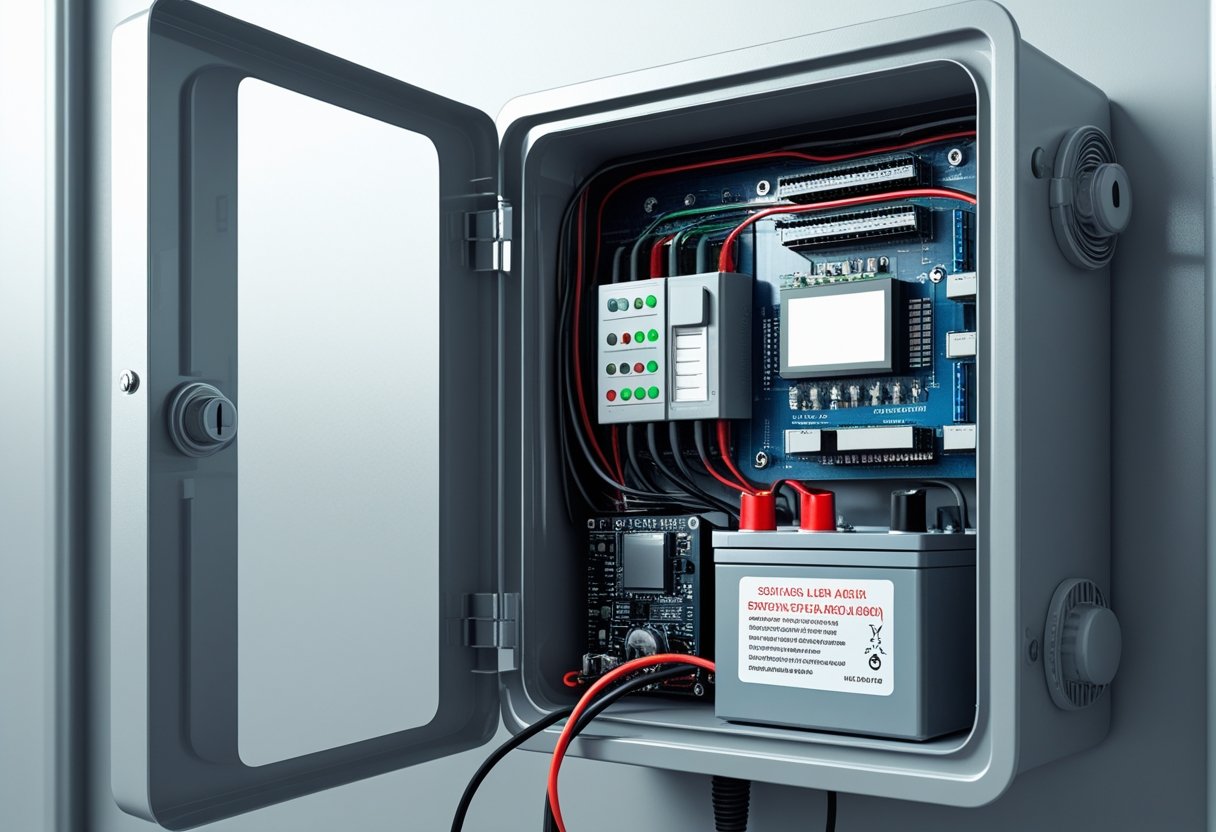When it comes to maintaining safety in your building, the reliability of your fire alarm control panel's battery backup is crucial. These backup systems ensure that your fire alarm continues to function during power outages, providing essential alerts when every second counts. Knowing how to choose and maintain the right battery can make a significant difference in ensuring the safety of occupants and compliance with regulations.
In Greater Houston, understanding the specific requirements for your fire alarm control panel is vital. These systems typically need batteries that can sustain at least 24 hours of standby power, followed by enough capacity to run the alarm during an emergency. This ensures that you are prepared for any situation, even when the primary power source is interrupted.
Regular maintenance and timely battery replacement are not just best practices; they are essential for optimal functionality. By staying informed about the needs of your fire alarm system, you can provide a safe environment and protect your property effectively.
Understanding Fire Alarm Control Panel Battery Backup
Battery backup is a critical component of fire alarm control panels, ensuring that systems remain operational during power outages. This section explores the purpose of battery backup, the differences between standby and backup power requirements, and an overview of sealed lead acid batteries commonly used in these systems.
Purpose of Battery Backup in Fire Alarm Systems
The primary function of battery backup in fire alarm systems is to maintain operational integrity during power interruptions. When the main power supply fails, the backup battery ensures the system remains functional, allowing for alarms to sound and notifications to be sent.
In many regions, regulations, including those set by NFPA 72, dictate that battery backup must support at least 24 hours of standby power. This means your system should be ready to activate in the event of an emergency. It is vital for ensuring safety in residential, commercial, and industrial buildings where fire alarms are essential.
Standby Power vs. Backup Power Requirements
It is important to differentiate between standby power and backup power. Standby power refers to the power required to keep the fire alarm panel operational when not in alarm mode, typically allowing the system to monitor for faults. Backup power, on the other hand, is necessary to activate alarms and notifications in the event of an active emergency.
The quality and specifications of your battery backup system can directly influence the performance of your fire alarm. Regular maintenance checks should include reviewing the battery capacity to ensure it meets or exceeds the required standards for both standby and backup power.
Overview of Sealed Lead Acid Batteries
Sealed lead acid (SLA) batteries are the most common type used in fire alarm control panels. They are favored for their reliability, affordability, and robust performance in security applications.
SLA batteries have various capacities, which can be tailored to the specific needs of your fire alarm system. They require minimal maintenance and can be installed in different orientations, making them versatile for various setups.
When selecting an SLA battery, consider the voltage and amp-hour rating to ensure it meets the requirements of your fire alarm system. Regular testing and replacement every 3-5 years will help maintain system reliability and compliance with safety regulations.
Ensuring that your fire alarm control panel has the right battery backup in place can significantly enhance your safety and security measures.
Battery Backup Requirements and Regulations
Understanding the requirements and regulations around battery backup for fire alarm control panels is crucial for ensuring safety and compliance. Adhering to proper standards minimizes risks and maintains the functionality of fire alarm systems during power outages.
Code Compliance and Industry Standards
When it comes to fire alarm systems, compliance with codes such as NFPA 72 is essential. This code outlines the necessary standards for battery backup systems, requiring them to provide at least 24 hours of standby power. Further, they must support the system for a minimum of five minutes during an alarm condition.
Local regulations may also specify unique requirements that you must follow. Regular inspections and maintenance are necessary to ensure that the batteries remain in optimal working condition and can perform effectively when needed.
Battery Backup Duration for Fire Alarm Panels
The duration of battery backup directly impacts the reliability of your fire alarm system. Standard regulations typically dictate that batteries must support at least 24 hours of standby power, followed by five minutes of full alarm load operation.
This is crucial because, during an emergency, your system must perform without external power. Therefore, you should select rechargeable batteries rated for 12 volts or based on the specific requirements of your fire alarm panel. This ensures compliance with industry standards and guarantees reliable operation.
Supervisory and Full Load Operation Explained
Supervisory operation refers to the battery's ability to monitor and maintain itself in a charged state. When the fire alarm system is in standby mode, the batteries need to be sufficiently charged to respond immediately when an alarm is triggered.
Full load operation indicates the performance level the battery must meet during an actual alarm event. This might require additional power for connected devices like alarms and notification systems. Proper sizing of the battery backup is vital to ensure the system can handle both supervisory and full load without any interruption.
Battery Capacity and Sizing Calculations
Understanding battery capacity and sizing calculations is crucial for ensuring the reliability of your fire alarm control panel. Proper sizing guarantees that your system functions correctly during power outages and meets regulatory standards.
Determining Battery Capacity Needs
To determine your battery capacity needs, consider the total current draw of your fire alarm system. This includes both standby and alarm currents.
- Standby Current: This is the power consumed when the system is in a dormant state.
- Alarm Current: This is the surge in power usage during an alarm event.
You can calculate the required capacity using the formula:
Battery Capacity (Ah) = (Standby Current × Standby Time) + (Alarm Current × Alarm Time).
Be sure to factor in the duration for which the battery must support the system. This will help in selecting a battery that can provide adequate power during emergencies.
Performing Battery Calculations
Performing battery calculations involves assessing both the voltage and current requirements of your system.
- Identify Components: List all components connected to the fire alarm panel and their respective current ratings.
- Calculate Total Current: Sum the current values for both standby and alarm conditions.
- Account for Voltage: Ensure that the battery voltage matches the requirements of your control panel (typically 12V for most systems).
Use a battery sizing calculator for more accurate results, which will guide you in selecting appropriate options based on your specific setup. Online resources can provide detailed information and examples for various system types.
Factors Affecting Battery Sizing
Several factors can influence your battery sizing decisions.
- System Type: Different fire alarm systems have varying power requirements. Systems categorized under NFPA 72 or BS 5839 will have specific guidelines to follow.
- Standby Duration: The length of time your system must operate without mains power directly affects battery size. Longer standby requirements necessitate larger capacity batteries.
- Temperature Conditions: Operating environments can impact battery performance. Higher temperatures may reduce battery lifespan and efficiency, making it essential to choose batteries that can withstand your locale's conditions.
Considering these factors ensures that your fire alarm system remains compliant and reliable during critical situations in the greater Houston area.
Selection and Installation of Battery Backups
When it comes to fire alarm control panel battery backups, understanding the selection and installation process is crucial. Your choice of battery type and installation techniques can significantly impact the reliability of your fire alarm system during power failures.
Choosing the Right Battery Type
Selecting the appropriate battery type is critical for ensuring consistent performance in your fire alarm system. Sealed lead acid (SLA) batteries are the most commonly used option. They are durable and provide reliable power. Choose batteries that meet the specific voltage and capacity requirements of your fire alarm panel.
Consider the amp-hour rating based on the system’s power needs during standby and alarm conditions. Ensure that the battery can supply power for the necessary duration per NFPA 72 standards, which generally call for at least four hours of standby power.
Wiring and Installation Guidelines
Proper wiring and installation are essential for the functionality of battery backups. Begin by following the manufacturer's instructions carefully. Use appropriate wiring gauges that accommodate the current requirements without overheating.
Color-coded wiring is beneficial for easy identification. Connect the battery’s positive terminal to the panel’s positive side and the negative terminal to the negative side. Ensure that all connections are secure to avoid any loss of power during emergencies.
Additionally, consider using fuses or circuit breakers on the battery lines to prevent damage from overcurrent scenarios.
Panel and Battery Box Considerations
When selecting and installing your fire alarm system, the placement of the control panel and battery box matters. Ensure that the battery box is accessible for maintenance and replacement.
Evaluate the environmental conditions where the battery will reside. It should be away from extreme temperatures or moisture, as this can severely impact battery life. Also, consider the size and weight of the battery in relation to the compartment to ensure a proper fit.
Confirm that the power supply within the control panel can accommodate the selected battery size and type, as mismatched components can lead to system failures.
Power Supplies for Fire Alarm Panels
The power supply of your fire alarm panel plays a vital role in its overall operation. A reliable power supply will ensure that both the panel and backup battery function effectively. It is advisable to choose a power supply that not only meets the voltage requirements but also supports the additional load during alarm conditions.
Investigate smart power supplies that feature built-in monitoring. These can alert you to battery issues or power supply failures before they become critical.
Also, ensure that the power supply is compliant with local fire safety regulations, particularly if you are in the greater Houston area. This compliance will help guarantee that your system operates seamlessly when you need it most.
Testing, Maintenance, and Replacement
Ensuring the reliability of your fire alarm control panel's battery backup is crucial for safety. Regular testing, vigilant monitoring for signs of degradation, and adhering to best practices for battery replacement are integral to maintaining effective fire alarm systems.
Recommended Inspection and Testing Intervals
You should inspect and test the battery backup of your fire alarm control panel at least twice a year. This regular schedule helps catch issues before they escalate into failures. Testing includes examining the overall battery capacity and functionality under simulated alarm conditions.
Consider integrating routine checks into your maintenance program. Utilize an Electrostatic Discharge (ESD) tester to measure voltage output and ensure it meets the required specifications. Document any findings and address discrepancies immediately to maintain system integrity.
Signs of Battery Degradation
Be aware of noticeable signs that could indicate battery degradation. These include:
- Reduced backup power duration: If the system fails to hold a charge as long as it used to, this is a red flag.
- Corrosion or leaks: Visible damage to the battery casing can compromise safety.
- Audible alerts from the control panel: Be attentive to any trouble signals indicating low battery status.
Regular monitoring can prevent unexpected failures during critical times. If you observe any of these symptoms, you must act quickly to prevent system failures.
Battery Replacement Best Practices
When it comes time for battery replacement, follow these best practices to ensure optimal performance. First, always use batteries that meet or exceed the manufacturer’s specifications for your specific fire alarm system.
- Maintain a record of battery replacement dates and conditions to track performance.
- Generally, consider replacing batteries every 3 to 4 years to avoid last-minute emergencies.
- Disconnect the battery according to the user manual directions before installation to prevent short circuits.
Using high-quality batteries not only improves system reliability but also enhances safety in your building environment. For your peace of mind, you may want to engage professional service providers in the greater Houston area to handle battery maintenance and replacement efficiently.
Frequently Asked Questions
Understanding the specifics of fire alarm control panel battery backup can help ensure your system operates effectively. Here are common inquiries regarding battery maintenance, costs, functionality, and specifications.
How should the battery backup for a fire alarm control panel be replaced?
To replace the battery backup, turn off the power to the control panel. Open the panel and disconnect the old battery. Replace it with a compatible unit, ensuring correct polarity before closing the panel and restoring power.
What is the typical cost of replacing a fire alarm control panel's battery backup?
The cost for replacing a fire alarm control panel's battery typically ranges from $30 to $100, depending on the battery type and the service provider. If you require professional installation, additional fees may apply.
How is the battery backup reset on a fire alarm control panel?
To reset the battery backup, first power down the system and replace the battery if necessary. After replacing, power the system back on, and check for any trouble signals indicating the battery is functioning properly.
What are common reasons for a fire alarm control panel battery backup to stop working?
Battery backups can fail due to age, improper installation, or a lack of maintenance. Corrosion and environmental factors may also contribute to battery issues, impacting its performance.
How long should a fire alarm control panel backup battery last?
Typically, a fire alarm control panel backup battery should last around three to five years. Regular inspections can help ensure that batteries are replaced before they fail.
What type of battery is commonly used in fire alarm control panels?
Most fire alarm control panels use sealed lead-acid (SLA) batteries or lithium-ion batteries. The specific type will vary based on the panel's requirements, so verify compatibility before purchasing a replacement.
.svg)



.svg)


.svg)



